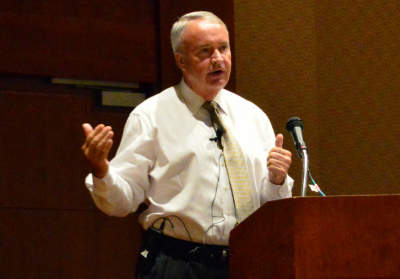It's time to say goodbye to the old hands-off approach toworkers' compensation risk management.
|That was the main message at the Agent's Role in Workers'Comp Risk Management & the Claims Process breakout session atWCEC on Aug. 18. The two-day session kicked off on Monday with apanel lead by Corey Mathews, CEO and executive vice presidentof PIA of Florida.
|On the panel was John McMahon, vice president of McMahon &Hadder in Fla.; Joe Carraher, senior account executive at LutgertInsurance in Fla.; and Lew Kachulis, president & CEO of SynergyComp Insurance Co. in Pa.
McMahon, who has worked in workers' compensation since 1979,emphasized that agents should be very involved with their clients.Rather than simply presenting clients with a policy and sellingthem the least expensive policy, McMahon says it is in both anagent and client's best interest to make sure the client iseducated in what they are getting. One of the most important partsof workers' comp that agents should help their clients with areaudits.
|“Agents should be involved with their clients,” says McMahon.“[It] helps retain clients, by going with them to audits and makingsure you know all the rules and work around them [to help clients],while still following [the rules].”
| Carraher also discussed the changing role ofthe agent in the workers' comp claims process. Previously, too manyagents were focused on dividends–and dividend hunting resulted inbad practices, like not reporting claims. Carraher explains thatdividends are now dramatically lower and the experience mod hasbecome the most important factor for employers.
Carraher also discussed the changing role ofthe agent in the workers' comp claims process. Previously, too manyagents were focused on dividends–and dividend hunting resulted inbad practices, like not reporting claims. Carraher explains thatdividends are now dramatically lower and the experience mod hasbecome the most important factor for employers.
Because of that, Carraher says agents should focus on takingcare of the mod, and in time the dividends will take care ofthemselves. He recommends that agents educate themselves on whatmoves the needle on mod, and utilize software to get real timeanalysis of claims–and educate the client on that analysis.
|“The days of ignoring claims are gone,” says Carraher. “Agentscan either get to higher ground or get crushed.”
| Kachulis' presentation focused on getting theemployer involved in workers' comp decisions. Typically CFOs areinvolved in the buying deicision, but Kachils emphasized theimportance of getting the CEO or owner of a company in on thedecision as well, because they both understand different aspects ofa safety culture purchase.
Kachulis' presentation focused on getting theemployer involved in workers' comp decisions. Typically CFOs areinvolved in the buying deicision, but Kachils emphasized theimportance of getting the CEO or owner of a company in on thedecision as well, because they both understand different aspects ofa safety culture purchase.
“CEOs are self-funding their claims,” says Kachulis. “They needto learn the indirect cost of a workplace accident.”
|To do that, Kachulis says agents should create spreadsheets onevery company with its average claims cost, its percentage ofclaims litigation, the average adjuster case load, and thepercentage of claims closed in 90 days. If the numbers are notcomparable to the industry average, its time for the agent andcompany to work together to lower their costs.
Want to continue reading?
Become a Free PropertyCasualty360 Digital Reader
Your access to unlimited PropertyCasualty360 content isn’t changing.
Once you are an ALM digital member, you’ll receive:
- All PropertyCasualty360.com news coverage, best practices, and in-depth analysis.
- Educational webcasts, resources from industry leaders, and informative newsletters.
- Other award-winning websites including BenefitsPRO.com and ThinkAdvisor.com.
Already have an account? Sign In
© 2024 ALM Global, LLC, All Rights Reserved. Request academic re-use from www.copyright.com. All other uses, submit a request to [email protected]. For more information visit Asset & Logo Licensing.








